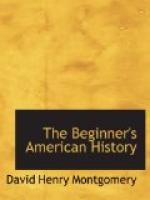[Illustration: FIRST GREAT SEAL OF THE UNITED STATES.]
[Illustration: SECOND GREAT SEAL OF THE UNITED STATES.]
On one of the two great seals[4] of the United States a pyramid is represented partly finished. That pyramid stands for our country. It shows how much has been done and how much still remains to be done. The men whose lives we have read in this little book were all builders. Little by little they added stone to stone, and so the good work grew. Now they have gone, and it is for us to do our part and make sure that the pyramid, as it rises, shall continue to stand square, and strong, and true.
[Footnote 4: Seals: the first great seal, having the eagle and the Latin motto “E Pluribus Unum,” meaning “Many in One,”—or one nation made up of many states,—was adopted June 20, 1782. The spread eagle signifies strength; the thirteen stars above his head, and the thirteen stripes on the shield on his breast, represent the thirteen original states; the olive branch, held in the eagle’s right talon, shows that America seeks peace, while the bundle of arrows in his left talon shows that we are prepared for war. This seal is used in stamping agreements or treaties made by the United States with other nations, and also for other important papers.
The second great seal, adopted at the same time, was never used. It was intended for stamping the wax on a ribbon attached to a treaty or other important paper, thus making a hanging seal. The Latin motto “Annuit Coeptis,” above the all-seeing eye looking down with favor on the unfinished pyramid, means “God has favored the Work.” The date MDCCLXXVI, or 1776, marks the Declaration of Independence. The Latin motto at the bottom, “Novus Ordo Seclorum,” means “A New Order of Ages”—or a new order of things, such as we have in this New World of America.]
What is said about the North and the South since the war? Tell about the growth of the South. What is said about the West? What about railroads? What about people going west?
How long is it since Columbus discovered America? What is said about the celebration of that discovery? What is said about one of the great seals of the United States? What does the unfinished pyramid stand for? What does it show us? What is said of the men whose lives we have read in this book? Is anything left for us to do?
A SHORT LIST OF BOOKS OF REFERENCE (For the Use of Teachers.)
This brief list is arranged alphabetically. It consists, with a few exceptions, of small, one-volume biographies; all of which are believed to be of acknowledged merit.
A much fuller reference list will be found in the appendix to the author’s larger work, entitled The Leading Facts of American History.
Balboa: Irving’s Companions of Columbus, and Winsor’s America, Vol. II.




